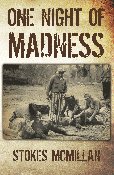When three white men invaded the home of an African American family in rural Attala County, the nation saw much of the story through the eyes of Billy McMillan, a photographer and reporter at his father-in-law's weekly paper, the Kosciusko Star-Herald. We hear all the time about Emmett Till, about Medgar Evers, about so many despicable events in Mississippi's past. Why never this particular story? Leon Turner shot and killed three of Mary Ella Harris' children, and also shot her husband—who later died from his wounds—and an older daughter, who survived. For its time, the story received extensive local and national media coverage.
One particular photo ended up garnering McMillan the 1950 Best Journalistic Photograph award from the National Press Photographers Association. That photo is now on the cover of "One Night of Madness" (Oak Harbor Publishing, 2009, $18.99), authored by the photographer's son, Stokes McMillan.
The author's mother, proud of her husband's accomplishment, had pasted it onto the cover of a scrapbook made from a 30-by-30-inch book, normally used for page layout at the paper, adding more as the coverage expanded far beyond Kosciusko. As a boy, Stokes McMillan occasionally looked at the photos in the scrapbook that his mother kept under the bed, but it wasn't until 2001 that he began to read the clippings.
"I laid the large scrapbook out on a table and turned to the first page. A headline from the January 29, 1950, St. Louis Post-Dispatch blared 'Murder in Mississippi' in bold print. I began to read, and time melted away as a story of violence, fear, race, love, revenge, politics and courtroom drama captured me. When I finally closed the cover, I knew that the story of this 1950 event deserved more than to be secreted within the pages of an old scrapbook—it deserved to be told, and ownership of the scrapbook made me the one to tell it," he writes.
After nearly eight years' research, eyewitness interviews and visits to the sites detailed in "One Night of Madness," McMillan wrote what he calls "… a true account of actual events as best as I could sort them out." Using the genre creative nonfiction, like Truman Capote had done with "In Cold Blood," McMillan lays it all bare, separating "One Night of Madness" into three parts: the people, the crime and the trials. He tells the story of how these people all knew each other and how the two races lived in close proximity in rural Attala County. He included extensive footnotes and an epilogue that tells what happened afterward to the book's principal players.
One of the strongest segments in "One Night of Madness" comes at the beginning of Part 3: "During America's era of slavery, the State of Mississippi, among other Southern states, failed to secure equal justice for all. Long after emancipation, African Americans remained subject to inequality before the law and were often victimized by society. In 1950 the trial of three accused child-murderers provided an opportunity for Mississippi to etch its own commitment to 'Equal Justice Under Law.' The nation was watching."
"The press dogged local officials, eager to obtain their comments about the case," McMillan writes. "Asked to provide a possible motive for the senseless murders, District Attorney Henry Rodgers offered that the three white men had been arrested during a previous visit to the home when they had tried to rape Mrs. Harris and her teenage daughter. Blaming the Harris family for the sheriff's arrival and their being taken into custody, the men broke out of jail and returned to the home in a 'drunken orgy of revenge.' The killings thus took on a name. The press began calling the crime the 'revenge murders.'"
Mississippi's reputation suffered again when the murders became lynchings. McMillan explains the definition of a lynching, as set by Tuskegee University: "[T]he nation's organizational expert on lynchings, classifies it as meeting the following conditions: 'There must be legal evidence that a person was killed. That person must have met death illegally. A group of three or more persons must have participated in the killing. The group must have acted under the pretext of service to Justice, Race, or Tradition.'"
State leaders hoped they would not be so classified even though they knew a horrible crime had been committed. Hodding Carter Jr., editor and publisher of the Greenville (Miss.) Delta Democrat-Times, then expressed "… the emotions of his fellow Mississippians … 'There was no color issue in this at all. People were outraged by the wanton murder of three children, just as people would be anywhere had this thing happened to any children.'" Nevertheless, the deaths of the children were classified as lynchings.
As difficult as it is to assimilate the horrors of this story, all the while trying to understand why it is not included in the pantheon of race-related incidents that crowd Mississippi's history, I thank Stokes McMillan for writing "One Night of Madness," detailing what led Leon Turner to wreak havoc on the family of Mary Ella Harris. McMillan told a story that had to be told.


